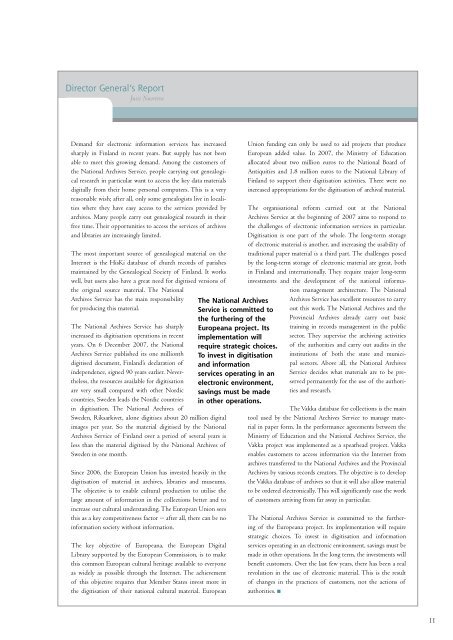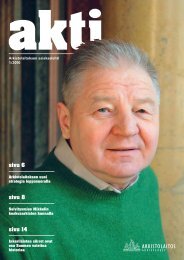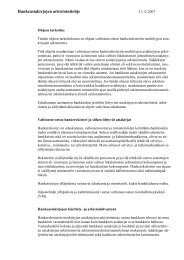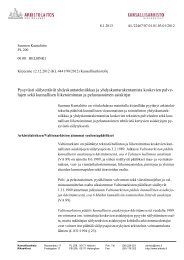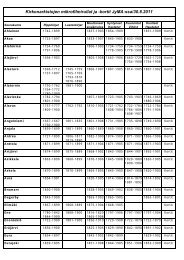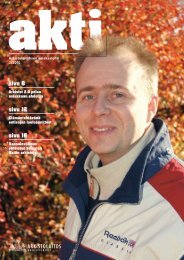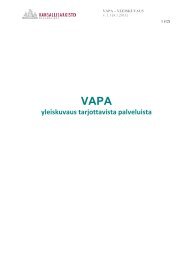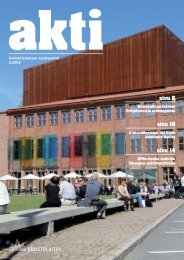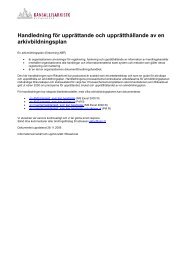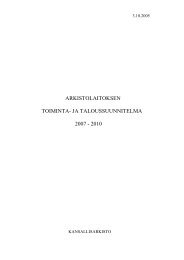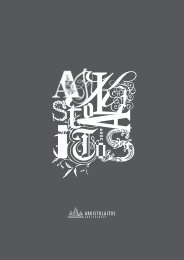Läs mera... - Arkistolaitos
Läs mera... - Arkistolaitos
Läs mera... - Arkistolaitos
Create successful ePaper yourself
Turn your PDF publications into a flip-book with our unique Google optimized e-Paper software.
Director General’s Report<br />
Jussi Nuorteva<br />
Demand for electronic information services has increased<br />
sharply in Finland in recent years. But supply has not been<br />
able to meet this growing demand. Among the customers of<br />
the National Archives Service, people carrying out genealogical<br />
research in particular want to access the key data materials<br />
digitally from their home personal computers. This is a very<br />
reasonable wish; after all, only some genealogists live in localities<br />
where they have easy access to the services provided by<br />
archives. Many people carry out genealogical research in their<br />
free time. Their opportunities to access the services of archives<br />
and libraries are increasingly limited.<br />
The most important source of genealogical material on the<br />
Internet is the HisKi database of church records of parishes<br />
maintained by the Genealogical Society of Finland. It works<br />
well, but users also have a great need for digitised versions of<br />
the original source material. The National<br />
Archives Service has the main responsibility<br />
for producing this material.<br />
The National Archives Service has sharply<br />
increased its digitisation operations in recent<br />
years. On 6 December 2007, the National<br />
Archives Service published its one millionth<br />
digitised document, Finland’s declaration of<br />
independence, signed 90 years earlier. Nevertheless,<br />
the resources available for digitisation<br />
are very small compared with other Nordic<br />
countries. Sweden leads the Nordic countries<br />
in digitisation. The National Archives of<br />
Sweden, Riksarkivet, alone digitises about 20 million digital<br />
images per year. So the material digitised by the National<br />
Archives Service of Finland over a period of several years is<br />
less than the material digitised by the National Archives of<br />
Sweden in one month.<br />
Since 2006, the European Union has invested heavily in the<br />
digitisation of material in archives, libraries and museums.<br />
The objective is to enable cultural production to utilise the<br />
large amount of information in the collections better and to<br />
increase our cultural understanding. The European Union sees<br />
this as a key competitiveness factor − after all, there can be no<br />
information society without information.<br />
The key objective of Europeana, the European Digital<br />
Library supported by the European Commission, is to make<br />
this common European cultural heritage available to everyone<br />
as widely as possible through the Internet. The achievement<br />
of this objective requires that Member States invest more in<br />
the digitisation of their national cultural material. European<br />
The National Archives<br />
Service is committed to<br />
the furthering of the<br />
Europeana project. Its<br />
implementation will<br />
require strategic choices.<br />
To invest in digitisation<br />
and information<br />
services operating in an<br />
electronic environment,<br />
savings must be made<br />
in other operations.<br />
Union funding can only be used to aid projects that produce<br />
European added value. In 2007, the Ministry of Education<br />
allocated about two million euros to the National Board of<br />
Antiquities and 1.8 million euros to the National Library of<br />
Finland to support their digitisation activities. There were no<br />
increased appropriations for the digitisation of archival material.<br />
The organisational reform carried out at the National<br />
Archives Service at the beginning of 2007 aims to respond to<br />
the challenges of electronic information services in particular.<br />
Digitisation is one part of the whole. The long-term storage<br />
of electronic material is another, and increasing the usability of<br />
traditional paper material is a third part. The challenges posed<br />
by the long-term storage of electronic material are great, both<br />
in Finland and internationally. They require major long-term<br />
investments and the development of the national information<br />
management architecture. The National<br />
Archives Service has excellent resources to carry<br />
out this work. The National Archives and the<br />
Provincial Archives already carry out basic<br />
training in records management in the public<br />
sector. They supervise the archiving activities<br />
of the authorities and carry out audits in the<br />
institutions of both the state and municipal<br />
sectors. Above all, the National Archives<br />
Service decides what materials are to be preserved<br />
permanently for the use of the authorities<br />
and research.<br />
The Vakka database for collections is the main<br />
tool used by the National Archives Service to manage material<br />
in paper form. In the performance agreements between the<br />
Ministry of Education and the National Archives Service, the<br />
Vakka project was implemented as a spearhead project. Vakka<br />
enables customers to access information via the Internet from<br />
archives transferred to the National Archives and the Provincial<br />
Archives by various records creators. The objective is to develop<br />
the Vakka database of archives so that it will also allow material<br />
to be ordered electronically. This will significantly ease the work<br />
of customers arriving from far away in particular.<br />
The National Archives Service is committed to the furthering<br />
of the Europeana project. Its implementation will require<br />
strategic choices. To invest in digitisation and information<br />
services operating in an electronic environment, savings must be<br />
made in other operations. In the long term, the investments will<br />
benefit customers. Over the last few years, there has been a real<br />
revolution in the use of electronic material. This is the result<br />
of changes in the practices of customers, not the actions of<br />
authorities.<br />
11


